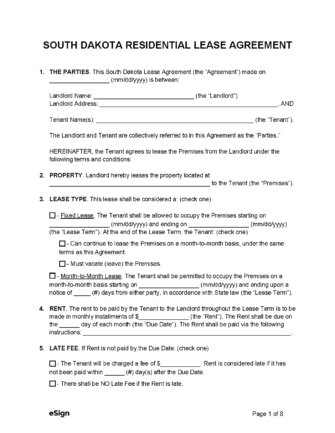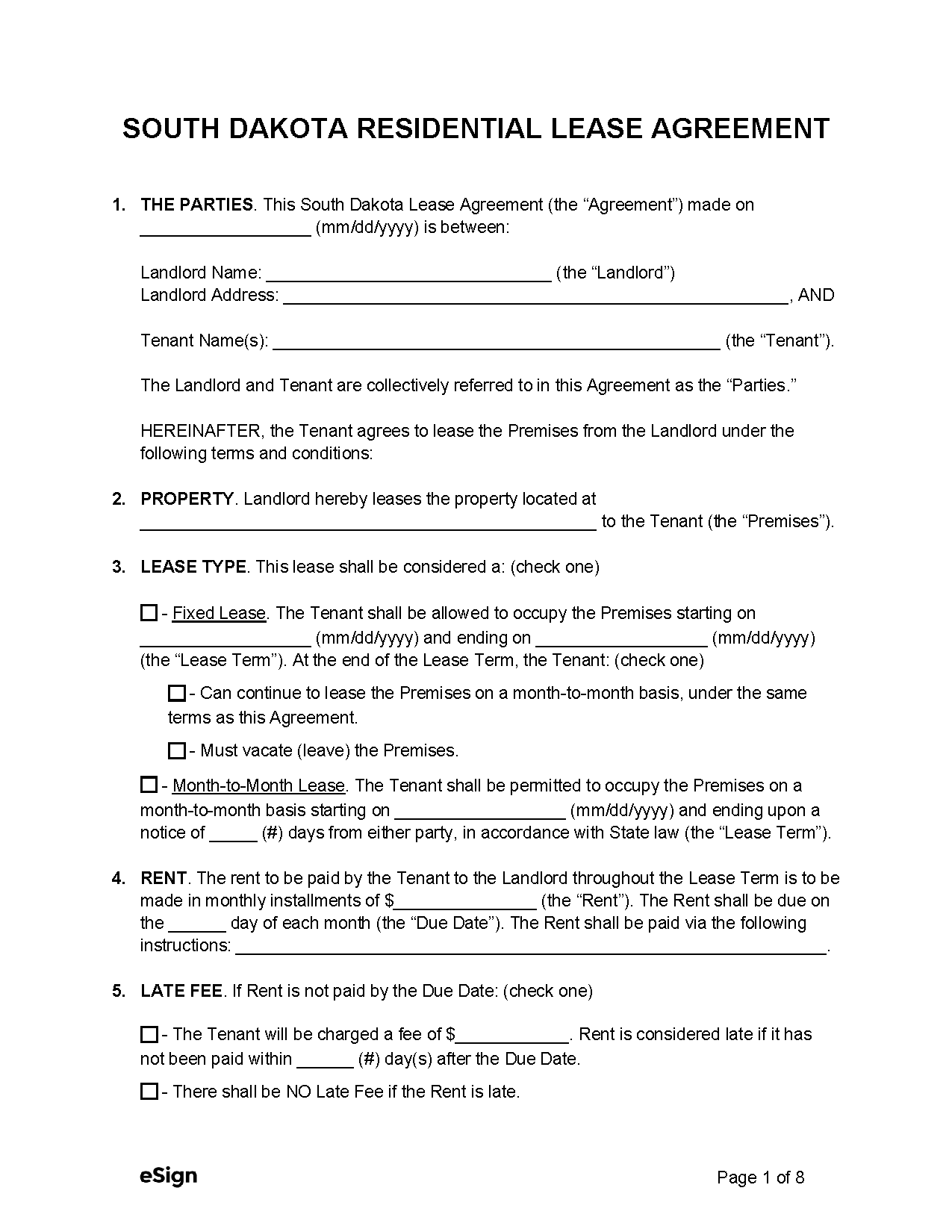
A South Dakota lease agreement is a document used by landlords to define the rental terms for a residential or commercial property. While the conditions will differ between the types of leases, each agreement will state the monthly rent amount and the expiration date of the tenancy (with the exception of a month-to-month lease).
A South Dakota lease agreement is a document used by landlords to define the rental terms for a residential or commercial property. While the conditions will differ between the types of leases, each agreement will state the monthly rent amount and the expiration date of the tenancy (with the exception of a month-to-month lease).
PDF Download
A South Dakota lease agreement is a document used by landlords to define the rental terms for a residential or commercial property. While the conditions will differ between the types of leases, each agreement will state the monthly rent amount and the expiration date of the tenancy (with the exception of a month-to-month lease).
5 | 1 Rating Downloads: 586
Rental Application – Used to collect and organize a lease applicant’s information as well as grant the landlord permission to run a background check.
Standard (1-year) Lease Agreement – The most common lease that allows a tenant to occupy a residential space for a fixed term in exchange for rent payments.
Commercial Lease Agreement – A rental contract for a property used for commercial activity only. Unlike residential leases, commercial agreements often last between three and five years.
Month-to-Month Lease Agreement – A rental contract that renews on a monthly basis unless terminated by either party with 30 days’ notice.
Rent-to-Own Agreement (Lease Option) – This lease contains conditions that allow the tenant to purchase the property at the end of the tenancy.
Roommate Agreement – A rental arrangement that allows multiple tenants to set terms and conditions for a shared residential space.
Sublease Agreement – Used by a tenant to rent their current dwelling to another person. In most cases, the primary tenant must receive permission from the landlord before subletting.
Maximum Amount ($) – A maximum of one month’s rent may be charged for a security deposit. [3]
Collecting Interest – State law does not specify how interest generated from security deposits shall be collected or distributed.
Returning to Tenant – Security deposits must be returned within 2 weeks after tenancy is terminated (60 days for commercial property). [4]
Itemized List Required? – Yes, if the tenant requests an itemized list within 45 days after tenancy is terminated (90 days for commercial).
Separate Bank Account? – No, there is no state law that requires landlords to keep security deposits in a separate bank account.
General Access – Landlords can access the property if they give the tenant reasonable notice. 24 hours is generally considered reasonable. [5]
Immediate Access – No notice is required in an emergency or situations where providing notice would be impractical.
Grace Period – There is no rent payment grace period in South Dakota law.
Maximum Late Fee ($) – Fees for late rent payment are not covered in state statutes.
Bad Check (NSF) Fee – Fees for bounced rent payment checks are not mentioned in state statutes.
Withholding Rent – After notifying the landlord, a tenant may withhold rent and deposit it into a separate account until the landlord repairs the issues mentioned in the written notice. [6]
Non-Payment of Rent – If three days have passed since the rent due date, the landlord can serve a 3-day notice to quit for non-payment. [7]
Non-Compliance – A landlord can terminate a lease using an immediate notice to quit if the tenant fails to comply with certain terms of the agreement. [8]
Tenant Maintenance – Tenants must maintain the premises and make necessary repairs to any damage they cause. [9]
Lockouts – Landlords are not lawfully permitted to prevent the tenant from accessing their rental property. [10]
Leaving Before the End Date – Tenant abandonment is not mentioned in state statutes.
Month-to-Month – A landlord or tenant can terminate a month-to-month tenancy by giving the other party a 1-month notice to terminate tenancy. [11]
Unclaimed Property – A landlord can dispose of any unclaimed property equal to or less than $500 left by the tenant once 10 days have passed since they quit the property. For abandoned property over $500, the landlord can only dispose of it after 30 days. [12]